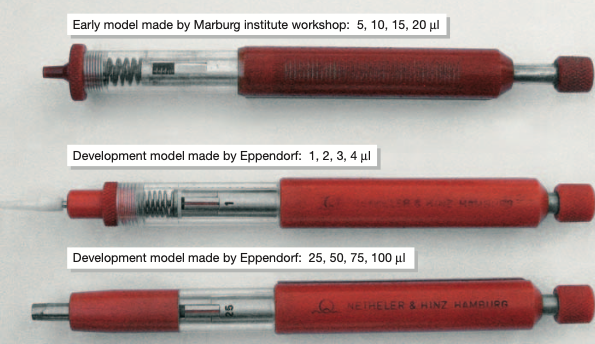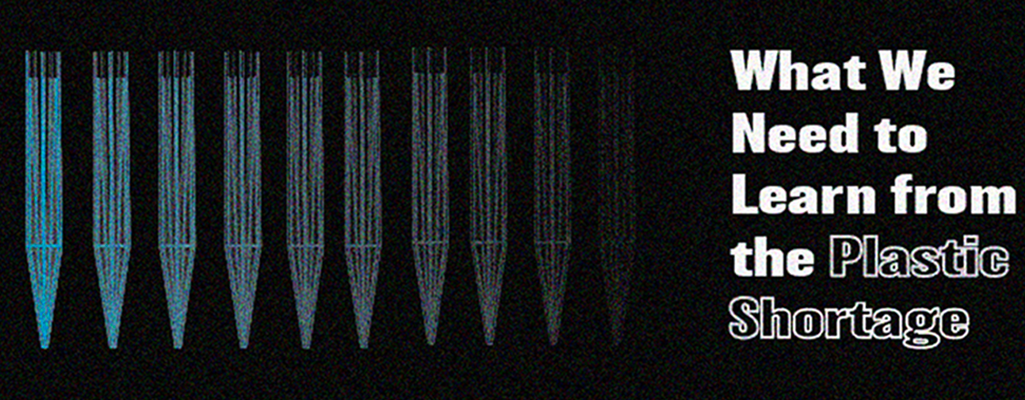At the moment, everything made of plastic is on back order. Pipette tips, in particular, have served as an alarming indicator to the issues happening along the supply chain. No one event appears to be the cause; instead, a combination of the explosion in COVID-19 testing last year and a string of natural disasters produced a domino effect resulting in barren shelves and empty tip boxes. Labs across the country have been feeling the strain of the plastic shortage all the way from labs performing health tests in infants to slowing our own research as we work out ways to conserve tips and tubes. The level of dependence we have on plastic consumables is alarming, so how did we get here?
In 1957, Heinrich Schnitger invented and filed a patent for the earliest model of the micropipette in Germany, at the peak of industry’s obsession with disposable plastics [1]. From its conception, the micropipette has always utilized plastic tips. Schnitger first retrofitted a tuberculin syringe with a plastic tip stretched from PE tubing, then, prior to development for mass production, he used Teflon® for its water repellant properties. However, since Teflon® cannot be melted down for injection molding, the production process was too involved and expensive for a single use product, so Teflon® was swapped out for the more inexpensive, newly available alternative—polypropylene (PEP). By then, the task of building and marketing the micropipette had been bought up by Eppendorf, who, at the same time, had also used PEP to develop a new, conveniently capped tube that could hold microliter volumes and withstand centrifugation speeds up to 30,000 x g. Eventually, the micropipette and all its accoutrement became the standard for pipetting microliter volumes of liquid.

Since then, micropipettes and their disposable tips have become indispensable to our ability to do science. The thought of operating without them is laughable. When the February Winter storm here in Texas resulted in power outages, processing plants that produce polypropylene resin, the raw material for plastic products [2], were shut down. According to Total, a Houston based oil and gas company, an estimated 85% of polypropylene production in the U.S. was affected directly by damage done during February’s extreme weather conditions. These raw material shortages have manifested as essential equipment on backorder on our end. In the face of surcharges and extra fees, it is time we reevaluated our reliance on plastic.
As we wait for the plastic tubes on perpetual back order to arrive, more and more people are noticing and thinking of the amount of plastic we consume in the lab. In 2014, bioscience research generated an estimated 5.5 million tons of plastic waste—2% of the global plastic waste that year [3]. The 3 R’s—reduce, reuse, recycle—are great ways to combat the plastic waste problem. You can reduce the plastics you have by purchasing glass alternatives; some labs, in the face of the shortage, have implemented ways to wash and reuse non-contaminated pipette tips; and institution-wide recycling initiatives are already widespread. It should be easy, right?
These changes in procedures aren’t impossible for every lab to implement; however, they can take a lot of time that could otherwise be spent doing valuable research. There are also many tradeoffs to the 3 R’s for plastics in science. Disposable materials ensure sterility and easy workflow. To reuse a pipette tip, you would need to set aside collection containers and sort out, while working, which tips are suitable for re-autoclaving and which contain contaminated material. Not to mention the plastic loses structural integrity every autoclave cycle, making the volume of the pipette tip less and less accurate each time.
There’s no question that most people doing scientific research are acutely aware of the climate problem, yet it’s still difficult as a researcher to avoid using plastic consumables. Every article about “greening your lab” focuses on what us doing the research can do to help limit waste and energy use. While I’m sure we would all love to do our part, we have our limits to what we can impact. Wider systemic change is necessary to amplify the effect of changes we want to make in our labs. For example, manufacturers cutting down on polystyrene and plastic packaging helps us limit the amount of plastic we throw away. Institutions can help us make better choices by subsidizing sustainable purchases such as buying glass petri dishes over plastic ones, or subsidizing water and energy costs from autoclaving reusable items. At this point, it’s not an issue of awareness. We know how much waste we produce—now we need the financial incentives in place to make sustainable choices easier.
We’re lucky to be a part of an institution that is taking some steps in the right direction. Since first adopting the Sustainability Master Plan in 2016, UT has made some progress on certain conservation goals they had set out. According to Jim Walker, the Director of Sustainability at UT, in the 5 year progress update he delivered last year, we reduced our energy consumption by 20% per square foot, and have made steps to becoming a zero waste campus—research waste diversion appears to be a limiting factor in these efforts while food waste and more general waste collection appears to have made progress [4]. For laboratory research specifically, we have managed to decrease our chemical inventory, and we have increased involvement in our Green Labs Program. Green Labs, in particular, aims to help labs on campus minimize waste, minimize hazardous chemical use, and reduce water and energy consumption. Progress is slow; not every goal set out by UT Sustainability was met, and it is likely that new funding initiatives are going to take much longer than initiatives focused on awareness and continuing existing programs.
The shortage we’re facing now is just another reminder that many of our current lab practices are holdovers from a more unsustainable past. When we can make the effort, let’s go above and beyond to not just keep our science going during this material shortage, but to be better and more conscious about how the waste we produce impacts the environment. Sustainability is ultimately an issue of systemic injustice. Climate change consistently affects the most vulnerable and marginalized of our population. When we only focus on individual action, those less fortunate are the ones left behind. Until incentives are in the right place, and it is more affordable to do so, the impact we have can only go so far.
[1] Klingenberg M. (2005). When a common problem meets an ingenious mind. EMBO reports, 6(9), 797–800. https://doi.org/10.1038/sj.embor.7400520. [2] Sheridan, Kate. “A Shortage of Tiny Pipette Tips Is Creating Huge Problems for Science.” STAT, 30 Apr. 2021, https://www.statnews.com/2021/04/28/pipette-tips-shortage/. [3] Urbina, M., Watts, A. & Reardon, E. Labs should cut plastic waste too. Nature 528, 479 (2015). https://doi.org/10.1038/528479c. [4] “2020 Mitchell Annual Sustainability Symposium.” YouTube, UT Austin Sustainability, 21 Dec. 2020, www.youtube.com/playlist?list=PL7Kg8lMDeeux31k1OTCr5V-emdvTO5dTk.
Leave a Reply